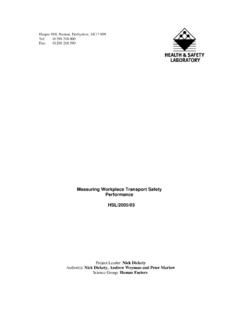Transcription of TECHNICAL ASSISTANCE REPORT EVALUATION OF …
1 TECHNICAL ASSISTANCE REPORT EVALUATION OF SPRAY INJECTION PATCHING G. W. Maupin, Jr. Principal Research Scientist Charles W. Payne Engineer I Virginia Transportation Research Council (A Cooperative Organization Sponsored Jointly by the Virginia Department of Transportation and the University of Virginia) Charlottesville, Virginia April 2003 VTRC 03-TAR11 ii DISCLAIMER The contents of this REPORT reflect the views of the author, who is responsible for the facts and the accuracy of the data presented herein.
2 The contents do not necessarily reflect the official views or policies of the Virginia Department of Transportation, the Commonwealth Transportation Board, or the Federal Highway Administration. This REPORT does not constitute a standard, specification, or regulation. Copyright 2003 by the Commonwealth of Virginia. iii ABSTRACT A preliminary telephone survey of users of spray injection patching equipment revealed general satisfaction. In addition, a demonstration and follow-up 2-month EVALUATION of a rented truck-mounted unit convinced Virginia Department of Transportation officials to purchase a unit for a more detailed EVALUATION .
3 The purchased unit was evaluated over a period with respect to cost- effectiveness of repairs, effectiveness during cold temperatures, and potential increased worker safety. The unit worked well and produced durable patches, even during cold temperatures. It was important to use clean aggregate and a different type of emulsion during extremely cold temperatures. A cost-benefit analysis indicated that patches installed by the spray injection unit were more cost-effective than repairs using the skin patching technique.
4 Fewer workers were exposed directly to traffic during the operation, which is a potential benefit, especially on highways with considerable traffic. The unit may be preferable and perhaps necessary where the number of available personnel is limited. TECHNICAL ASSISTANCE REPORT EVALUATION OF SPRAY INJECTION PATCHING G. W. Maupin, Jr. Principal Research Scientist Charles W. Payne Engineer I INTRODUCTION Potholes are an annoyance and a hazard for the traveling public, and their repair is costly.
5 The conventional methods that are used can be effective if done properly and during the time of year when warmer temperatures are prevalent; however, potholes usually begin to develop during the winter months due to freeze-thaw cycles. Therefore, patching must be done on short notice or on an emergency basis during the winter months when cold temperatures are predominant. The cold temperatures and frequent wet conditions make the chances of achieving successful patches minimal. Frequently, potholes that are patched during the winter months have to be patched repeatedly.
6 As part of the research done by the Strategic Highway Research Program (SHRP) in the late 1980s and early 1990s, an effort was made to determine the most effective and economical patching methods. In 1993, SHRP published Innovative Materials Development and Part of this study was devoted to pothole repair. A total of 1,250 pothole patches were placed at eight test sites in the United States and Canada using different proprietary, state-specified, and local cold-mix patching materials. Several installation techniques were used to determine an optimum combination of materials and procedures for improving the cost-effectiveness of patching operations.
7 Two conclusions of the SHRP study were that high-quality cold-mix materials and the spray injection method should be used for winter-time pothole repair. The cost of continually patching the same holes with poor-quality materials could be offset by paying more for high-quality material that offered a longer service life. The findings of the SHRP research project were that the spray injection patch method was the least expensive and the patch service life was much better than with the other patching methods tested in the study.
8 The early performance results of this study are shown in Figure 1. The plot shows the percent failed at the last EVALUATION , which varied from 35 to 84 weeks depending on the location of the test section. In 1996, an RA-300 truck-mounted spray injection patcher was demonstrated to Virginia Department of Transportation (VDOT) personnel at several residencies by a representative from the Rosco Manufacturing Co. After the demonstrations, a telephone survey was made by the author to several states that were using the spray injection patching method.
9 The comments from the different agencies contacted are provided in Appendix A. It was the consensus of the states contacted that the spray injection patching method was superior to any other patching methods, with a life expectancy of 4 to 5 years. In addition, it was learned during the survey that pothole 2 Figure 1. Patches Failed by Procedure (at last EVALUATION ) patching during the winter using the spray injection patching method was more successful than the cold-mix patching that is normally used in cold weather.
10 In 1997, VDOT leased an RA-300 ROSCO patcher for 2 months and used it in the Lynchburg and Salem districts. During that period, cold-mix patches were also placed for comparison purposes. The patches were monitored by a team of evaluators from each district for 1 year, and it was concluded that the spray injection patches lasted longer and were more economical. The total cost of the materials, personnel, and equipment for placing tons of material was $3,950 for the spray injection patches and $4,564 for the cold-mix patches.






